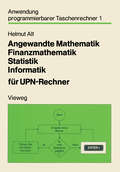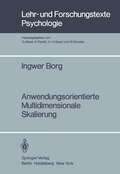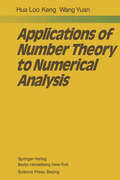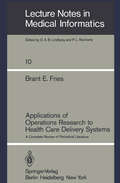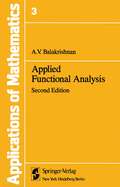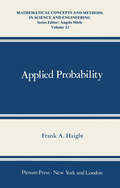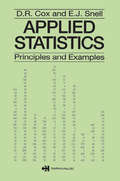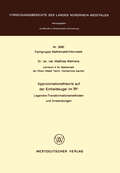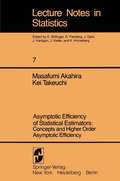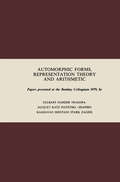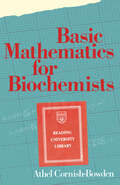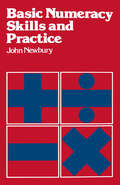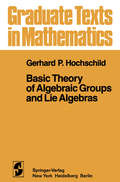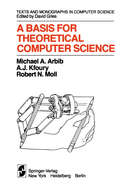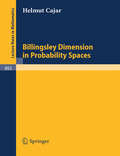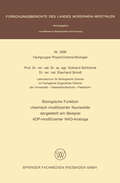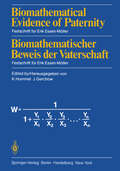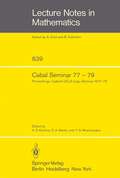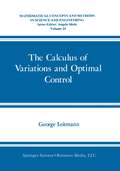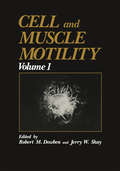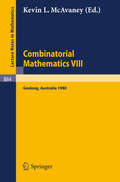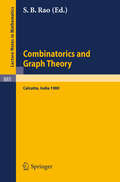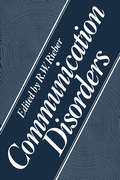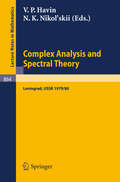- Table View
- List View
Angewandte Mathematik, Finanzmathematik, Statistik, Informatik für UPN-Rechner (Anwendung programmierbarer Taschenrechner #1)
by Helmut AltAnwendungsorientierte Multidimensionale Skalierung (Lehr- und Forschungstexte Psychologie #1)
by I. BorgApplications of Number Theory to Numerical Analysis
by L.-K. Hua Y. WangOwing to the developments and applications of computer science, ma thematicians began to take a serious interest in the applications of number theory to numerical analysis about twenty years ago. The progress achieved has been both important practically as well as satisfactory from the theoretical view point. It'or example, from the seventeenth century till now, a great deal of effort was made in developing methods for approximating single integrals and there were only a few works on multiple quadrature until the 1950's. But in the past twenty years, a number of new methods have been devised of which the number theoretic method is an effective one. The number theoretic method may be described as follows. We use num ber theory to construct a sequence of uniformly distributed sets in the s dimensional unit cube G , where s ~ 2. Then we use the sequence to s reduce a difficult analytic problem to an arithmetic problem which may be calculated by computer. For example, we may use the arithmetic mean of the values of integrand in a given uniformly distributed set of G to ap s proximate the definite integral over G such that the principal order of the s error term is shown to be of the best possible kind, if the integrand satis fies certain conditions.
Applications of Operations Research to Health Care Delivery Systems: A Complete Review of Periodical Literature (Lecture Notes in Medical Informatics #10)
by Brant E. FriesApplied Functional Analysis: a (Stochastic Modelling and Applied Probability #3)
by Alampallam V. BalakrishnanIn preparing the second edition, I have taken advantage of the opportunity to correct errors as well as revise the presentation in many places. New material has been included, in addition, reflecting relevant recent work. The help of many colleagues (and especially Professor J. Stoer) in ferreting out errors is gratefully acknowledged. I also owe special thanks to Professor v. Sazonov for many discussions on the white noise theory in Chapter 6. February, 1981 A. V. BALAKRISHNAN v Preface to the First Edition The title "Applied Functional Analysis" is intended to be short for "Functional analysis in a Hilbert space and certain of its applications," the applications being drawn mostly from areas variously referred to as system optimization or control systems or systems analysis. One of the signs of the times is a discernible tilt toward application in mathematics and conversely a greater level of mathematical sophistication in the application areas such as economics or system science, both spurred undoubtedly by the heightening pace of digital computer usage. This book is an entry into this twilight zone. The aspects of functional analysis treated here are rapidly becoming essential in the training at the advance graduate level of system scientists and/or mathematical economists. There are of course now available many excellent treatises on functional analysis.
Applied Probability (Mathematical Concepts and Methods in Science and Engineering #23)
by Frank A. HaightProbability (including stochastic processes) is now being applied to virtually every academic discipline, especially to the sciences. An area of substantial application is that known as operations research or industrial engineering, which incorporates subjects such as queueing theory, optimization, and network flow. This book provides a compact introduction to that field for students with minimal preparation, knowing mainly calculus and having "mathe matical maturity." Beginning with the basics of probability, the develop ment is self-contained but not abstract, that is, without measure theory and its probabilistic counterpart. Although the text is reasonably short, a course based on this book will normally occupy two semesters or three quarters. There are many points in the discussions and problems which require the assistance of an instructor for completeness and clarity. The book is designed to give equal emphasis to those applications which motivate the subject and to appropriate mathematical techniques. Thus, the student who has successfully completed the course is ready to turn in either of two directions: towards direct study of research papers in operations research, or towards a course in abstract probability, for which this text provides the intuitive background. Frank A. Haight Pennsylvania State University vii Contents 1. Discrete Probability .................................................. 1 1.1. Applied Probability. . . . . . . . . . . . . . . . .. . . . . . . . . . . . . . . . . . . . . . . . . . . . . . . . . . . 1 1.2. Sample Spaces ......................................................... 3 1.3. Probability Distributions and Parameters. . . . . . . . . . . . . . . . . . . . . . . . . . . . . 7 1.4. The Connection between Distributions and Sample Points: Random Variables. . . . . . . . . . . . . . . . . . . . . . . . . . . . . . . . . 10 . . . . . . . . . . . . . . . . . . .
Applied Statistics - Principles and Examples
by D.R. CoxThis book should be of interest to senior undergraduate and postgraduate students of applied statistics.
Applied Statistics - Principles and Examples
by D.R. CoxThis book should be of interest to senior undergraduate and postgraduate students of applied statistics.
Approximationstheorie auf der Einheitskugel im R3: Legendre-Transformationsmethoden und Anwendungen (Forschungsberichte des Landes Nordrhein-Westfalen #3090)
by Matthias WehrensAsymptotic Efficiency of Statistical Estimators: Concepts and Higher Order Asymptotic Efficiency (Lecture Notes in Statistics #7)
by Masafumi Akahira Kei TakeuchiThis monograph is a collection of results recently obtained by the authors. Most of these have been published, while others are awaitlng publication. Our investigation has two main purposes. Firstly, we discuss higher order asymptotic efficiency of estimators in regular situa tions. In these situations it is known that the maximum likelihood estimator (MLE) is asymptotically efficient in some (not always specified) sense. However, there exists here a whole class of asymptotically efficient estimators which are thus asymptotically equivalent to the MLE. It is required to make finer distinctions among the estimators, by considering higher order terms in the expansions of their asymptotic distributions. Secondly, we discuss asymptotically efficient estimators in non regular situations. These are situations where the MLE or other estimators are not asymptotically normally distributed, or where l 2 their order of convergence (or consistency) is not n / , as in the regular cases. It is necessary to redefine the concept of asympto tic efficiency, together with the concept of the maximum order of consistency. Under the new definition as asymptotically efficient estimator may not always exist. We have not attempted to tell the whole story in a systematic way. The field of asymptotic theory in statistical estimation is relatively uncultivated. So, we have tried to focus attention on such aspects of our recent results which throw light on the area.
Automorphic Forms, Representation Theory and Arithmetic: Papers presented at the Bombay Colloquium 1979 (Tata Institute Studies in Mathematics)
by S. Gelbart G. Harder K. Iwasawa H. Jaquet N.M. Katz I. Piatetski-Shapiro S. Raghavan T. Shintani H.M. Stark D. ZagierInternational Colloquium an Automorphic Forms, Representation Theory and Arithmetic. Published for the Tata Institute of Fundamental Research, Bombay
Basic Mathematics for Biochemists
by A. Cornish-BowdenSome teachers of biochemistry think it positively beneficial for students to struggle with difficult mathematics. I do not number myself among these people, although I have derived much personal pleasure from the study of mathematics and from applying it to problems that interest me in biochemistry. On the contrary, I think that students choose courses in biochemistry out of interest in biochemistry and that they should not be encumbered with more mathematics than is absolutely required for a proper understanding of biochemistry. This of course includes physical chemistry, because a biochemist ignorant of physical chemistry is no biochemist. I have been guided by these beliefs in writing this book. I have laid heavy emphasis on those topics, such as the use of logarithms, that play an important role in biochemistry and often cause problems in teaching; I have ignored others, such as trigonometry, that one can manage without. The proper treatment of statistics has been more difficult to decide. Although it clearly plays an important part in all experi mental sciences, it is usually preferable to treat it as a subject in its own right and not to try to incorporate it into a course of elementary mathematics. In this book, therefore, I have used a few examples from statistics to illustrate more general points, but I have not discussed it for its own sake.
Basic Theory of Algebraic Groups and Lie Algebras (Graduate Texts in Mathematics #75)
by G. P. HochschildThe theory of algebraic groups results from the interaction of various basic techniques from field theory, multilinear algebra, commutative ring theory, algebraic geometry and general algebraic representation theory of groups and Lie algebras. It is thus an ideally suitable framework for exhibiting basic algebra in action. To do that is the principal concern of this text. Accordingly, its emphasis is on developing the major general mathematical tools used for gaining control over algebraic groups, rather than on securing the final definitive results, such as the classification of the simple groups and their irreducible representations. In the same spirit, this exposition has been made entirely self-contained; no detailed knowledge beyond the usual standard material of the first one or two years of graduate study in algebra is pre supposed. The chapter headings should be sufficient indication of the content and organisation of this book. Each chapter begins with a brief announcement of its results and ends with a few notes ranging from supplementary results, amplifications of proofs, examples and counter-examples through exercises to references. The references are intended to be merely suggestions for supplementary reading or indications of original sources, especially in cases where these might not be the expected ones. Algebraic group theory has reached a state of maturity and perfection where it may no longer be necessary to re-iterate an account of its genesis. Of the material to be presented here, including much of the basic support, the major portion is due to Claude Chevalley.
A Basis for Theoretical Computer Science (Monographs in Computer Science)
by M.A. Arbib A.J. Kfoury R.N. MollComputer science seeks to provide a scientific basis for the study of inform a tion processing, the solution of problems by algorithms, and the design and programming of computers. The last forty years have seen increasing sophistication in the science, in the microelectronics which has made machines of staggering complexity economically feasible, in the advances in programming methodology which allow immense programs to be designed with increasing speed and reduced error, and in the development of mathematical techniques to allow the rigorous specification of program, process, and machine. The present volume is one of a series, The AKM Series in Theoretical Computer Science, designed to make key mathe matical developments in computer science readily accessible to under graduate and beginning graduate students. Specifically, this volume takes readers with little or no mathematical background beyond high school algebra, and gives them a taste of a number of topics in theoretical computer science while laying the mathematical foundation for the later, more detailed, study of such topics as formal language theory, computability theory, programming language semantics, and the study of program verification and correctness. Chapter 1 introduces the basic concepts of set theory, with special emphasis on functions and relations, using a simple algorithm to provide motivation. Chapter 2 presents the notion of inductive proof and gives the reader a good grasp on one of the most important notions of computer science: the recursive definition of functions and data structures.
Biologische Funktion chemisch modifizierter Nucleotide dargestellt am Beispiel ADP-modifizierter NAD-Analoga (Forschungsberichte des Landes Nordrhein-Westfalen #3039)
by Eckhard SchlimmeBiomathematical Evidence of Paternity / Biomathematischer Beweis der Vaterschaft: Festschrift for Erik Essen-Möller / Festschrift für Erik Essen-Möller
by K. Hummel J. GerchowCabal Seminar 77 – 79: Proceedings, Caltech-UCLA Logic Seminar 1977 – 79 (Lecture Notes in Mathematics #839)
by A. S. Kechris D. A. Martin Y. N. MoschovakisThe Calculus of Variations and Optimal Control: An Introduction (Mathematical Concepts and Methods in Science and Engineering #24)
by George LeitmannWhen the Tyrian princess Dido landed on the North African shore of the Mediterranean sea she was welcomed by a local chieftain. He offered her all the land that she could enclose between the shoreline and a rope of knotted cowhide. While the legend does not tell us, we may assume that Princess Dido arrived at the correct solution by stretching the rope into the shape of a circular arc and thereby maximized the area of the land upon which she was to found Carthage. This story of the founding of Carthage is apocryphal. Nonetheless it is probably the first account of a problem of the kind that inspired an entire mathematical discipline, the calculus of variations and its extensions such as the theory of optimal control. This book is intended to present an introductory treatment of the calculus of variations in Part I and of optimal control theory in Part II. The discussion in Part I is restricted to the simplest problem of the calculus of variations. The topic is entirely classical; all of the basic theory had been developed before the turn of the century. Consequently the material comes from many sources; however, those most useful to me have been the books of Oskar Bolza and of George M. Ewing. Part II is devoted to the elementary aspects of the modern extension of the calculus of variations, the theory of optimal control of dynamical systems.
Cell and Muscle Motility
by Robert M. Dowben Jerry W. ShayMotility is a fundamental property of living systems, from the cytoplasmic streaming of unicellular organisms to the most highly differentiated and devel oped contractile system of higher organisms, striated muscle. Research on var ious aspects of motile systems in muscle and undifferentiated or non muscle cells has been developing at an ever more rapid pace in the laboratories of investiga tors with a wide variety of backgrounds using methodologies varying from me chanics to the most sophisticated physical measurements. Significant contri butions to our understanding of motility are coming from the disciplines of cell biology, biochemistry, pharmacology, molecular biology, biophysics, and physiology. The findings have relevance not only to basic scientists but to clinicians in such diverse fields as cardiology and neurology and to scientists in the more traditional physical sciences. Cell and Muscle Motility is a new multivolume series of essays by distinguished research workers in various fields whose work has a common thread of dealing with one aspect or another of motility. The essays are meant to focus on topics of current interest, to be critical rather than exhaustive, and to indicate the current trends of research efforts. The series is intended to foster an interchange of concepts among various workers in the field and to serve as a reference for students and workers who wish to familiarize themselves with the most current progress in motility.
